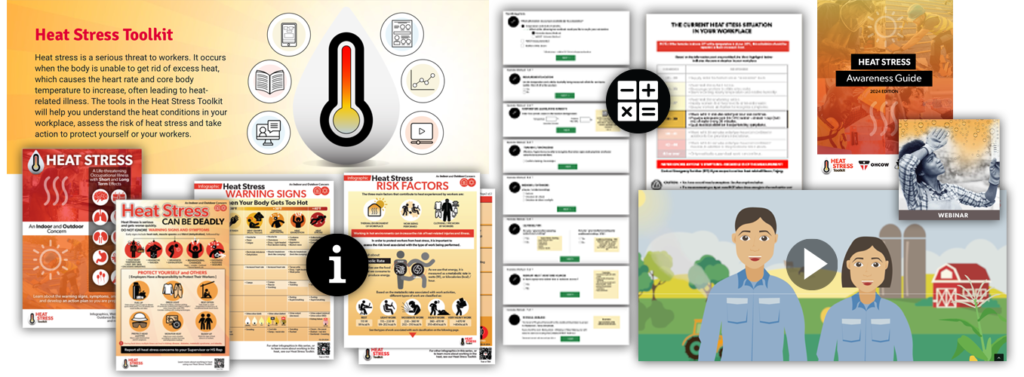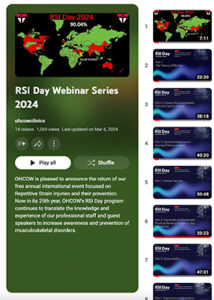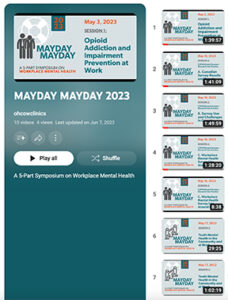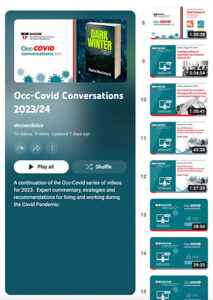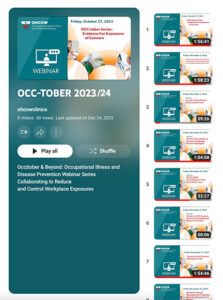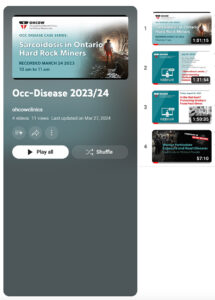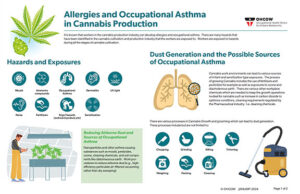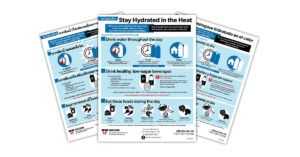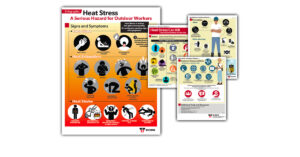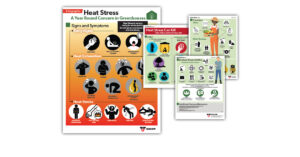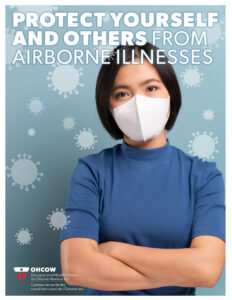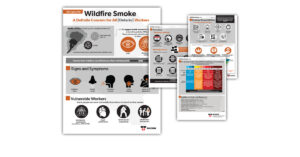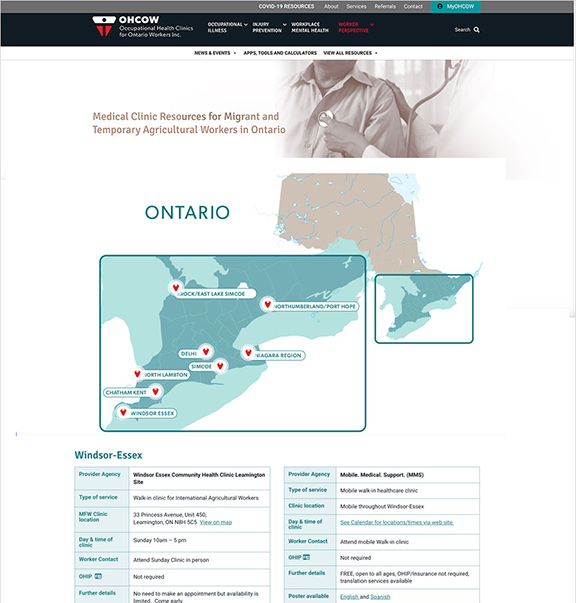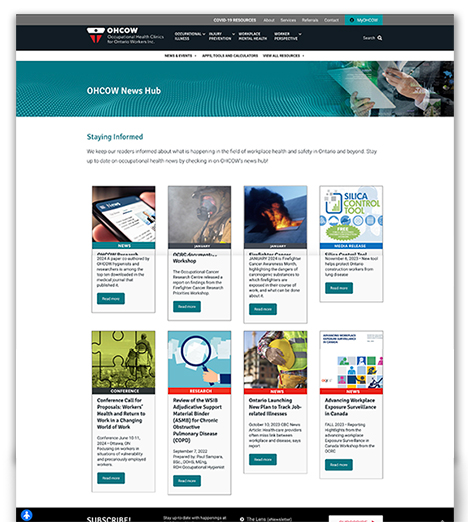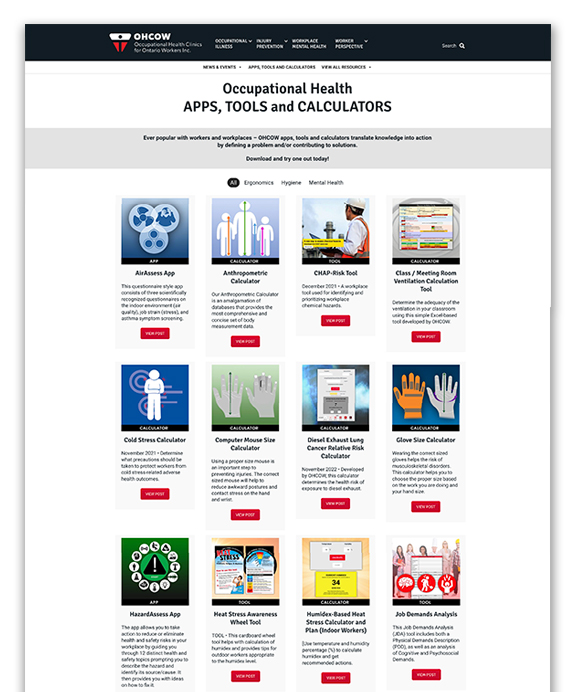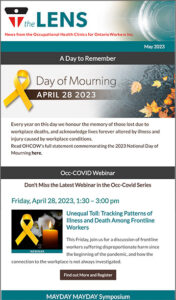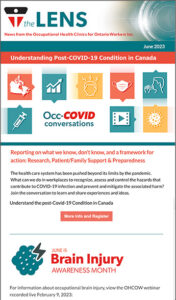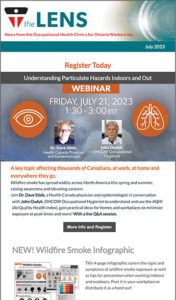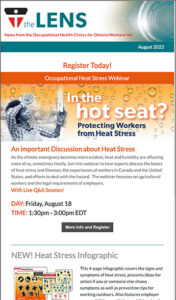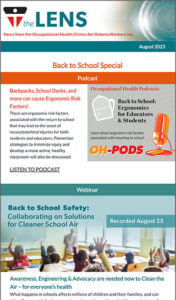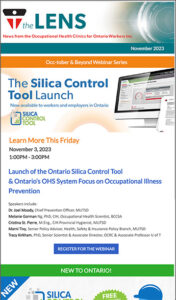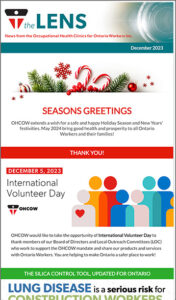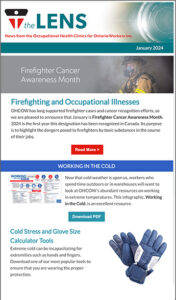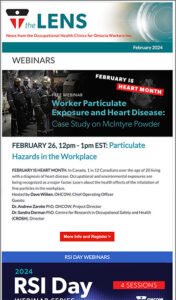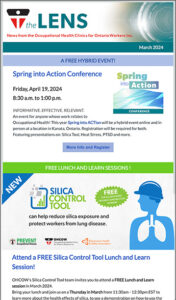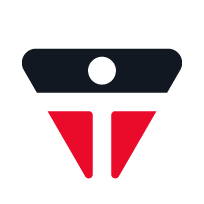Apps, Tools and Calculators
OHCOW's popular tools and calculators are always being updated for ease of use and to reflect changing factors in work environments. In the past year, some tools that were previously just available on an Excel Sheet are now moved to the web and apps are available, for both I0S and Google platforms. OHCOW has also created a new log-in platform that will provide personalized e-Courses and other features, MyOhcow.
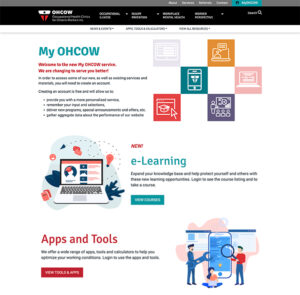 More Options, Better Service
More Options, Better Service
One of the most exciting developments at OHCOW over the past year has been the creation of a new online hub for users to sign into their own OHCOW accounts. From there they can register for webinars, eCourses and programs. Individualized certificates can be issued upon completion of learning content. Tools and Calculators can log their personal information. OHCOW can gather data to for information about users as it relates to OHCOW materials and access.
Creating an account is free and will allow OHCOW to:
- provide users with a more personalized service,
- remember users' input and selections,
- deliver new programs, special announcements and offers, etc.
- gather aggregate data about the performance of our website
Easier, More Convenient Use
 The Office Ergo Calculator, Anthropometric Calculator, and Cold Stress Calculator have all been updated and revised. Previously they were downloadable programs in Excel or Power Point. Errors could occur in these calculators depending on repeated opening of the page and Windows security features. Use of the calculators did not require login and information could not be tracked or updated.
The Office Ergo Calculator, Anthropometric Calculator, and Cold Stress Calculator have all been updated and revised. Previously they were downloadable programs in Excel or Power Point. Errors could occur in these calculators depending on repeated opening of the page and Windows security features. Use of the calculators did not require login and information could not be tracked or updated.
The Cold Stress, Anthropometric and Office Ergo Calculators are now in a web based format and a mobile APP exists for each. The Anthropometric Calculator has improved graphics and re-organization of tables, and can now be exported to the Office Ergo Calculator. The Office Ergo Calculator has improved audio, graphics, and video. Its options now include metric or imperial measurements, keyboard tray selection (height adjustable, on desk), and dual monitors. Variables now include monitor distance and arm length.
 The Keyboard Shortcut Tutorial was PowerPoint based and in the latest update was turned into a web-based format with a mobile app and enhanced video and graphics. A landing page allows the user an introduction to the tool and choice of operating system (Mac or Windows) and Language (English or French).
The Keyboard Shortcut Tutorial was PowerPoint based and in the latest update was turned into a web-based format with a mobile app and enhanced video and graphics. A landing page allows the user an introduction to the tool and choice of operating system (Mac or Windows) and Language (English or French).
A New OHCOW Service Makes Learning Easier
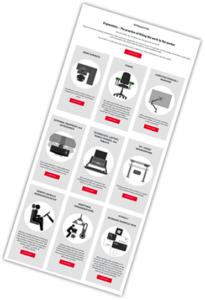 Office ergonomics is more important now than it has ever been before in our efforts to decrease and/or eliminate musculoskeletal disorders. Many workplaces do not have the financial resources (or time) to correctly train their workers in ergonomics, and specifically to identify and correct office set-up and use challenges. Building on the popular Office Ergonomics Ergo Reference Guide, the Office Ergonomics e-Learning Course breaks down the key ergonomic principles of workstation components into modules that allow users to progress at their own pace, while learning how to recognize, assess, and control the ergonomic hazards related to computer work wherever it is done.
Office ergonomics is more important now than it has ever been before in our efforts to decrease and/or eliminate musculoskeletal disorders. Many workplaces do not have the financial resources (or time) to correctly train their workers in ergonomics, and specifically to identify and correct office set-up and use challenges. Building on the popular Office Ergonomics Ergo Reference Guide, the Office Ergonomics e-Learning Course breaks down the key ergonomic principles of workstation components into modules that allow users to progress at their own pace, while learning how to recognize, assess, and control the ergonomic hazards related to computer work wherever it is done.
![]() A new web-based app from OHCOW that allows you to accurately and efficiently capture the Physical, Sensory, Cognitive and Psychosocial demands of any job. This new online tool allows you to select the demands that are relevant to the job you are assessing and then steps you through each and every section in detail. After creating a quick job profile, you set up the relevant tasks and assign the various task elements. You can even include photos to enhance the job record. Additional sections include:
A new web-based app from OHCOW that allows you to accurately and efficiently capture the Physical, Sensory, Cognitive and Psychosocial demands of any job. This new online tool allows you to select the demands that are relevant to the job you are assessing and then steps you through each and every section in detail. After creating a quick job profile, you set up the relevant tasks and assign the various task elements. You can even include photos to enhance the job record. Additional sections include:
- Administrative Considerations
- Personal Protective Equipment (PPE)
- Tools, Equipment, and Materials
- Environmental Considerations
- Strength Demands
- Body Posture Frequency
- Sensory Demands
- Cognitive Demands
- Psychosocial Factors
You use simple checklists, picklists and text fields to enter information and you can even red flag items that are of concern.
Once all sections are finalized, you are presented with a complete Job Demands Analysis (JDA) that can be saved for future re-use and downloaded as a PDF for reference and record keeping purposes.
An Advanced Tool to Protect Workers
On November 3 2023, Occupational Health Clinics for Ontario Workers introduced the Silica Control Tool (SCT) a tool that will help protect workers from lung disease caused by inhaling the dust of crystalline silica, which is found in sand, rock, gravel, concrete, brick, stone, mortar, granite, glass, ceramics and many other materials. This is year one of a five-year plan. The Tool’s user interface has undergone a facelift for Ontario and has been fully customized to meet Ontario’s health and safety regulation and standards. The SCT is available at no charge to any worker or employer at risk of exposure to silica dust, the tool is easy to use and can be downloaded to a phone, laptop or desktop.
Dr. Joel Moody, Chief Prevention Officer/ Assistant Deputy Minister, Ministry of Labour, Immigration, Training and Skills Development, said on the day of the launch that "The Silica Control Tool will help empower employers and workers - from workplaces and operations of all sizes - to understand the hazards and prevention strategies related to working with silica. I want to recognize and thank OHCOW for their leadership to make this project happen."
OHCOW sent a media release and launched a social media campaign to inform the construction industry of the new tool and provide links to OHCOW's SCT page. This page features more information, instructions and links to register. The response to the social media posts saw a 50%+ increase in reactions, including "likes" and favourable comments.
Through a special budget, the project hired an external media company that helped to draw increased traffic to the web page, and created materials such as banners, infographics, posters, walllet cards and stickers.
A sample of the ads placed on social media, that linked to the SCT landing page on OHCOW's website:
The boosted posts resulted in more than 14,000 visits to the landing page. The registration page has more than 28,000 visits to date.
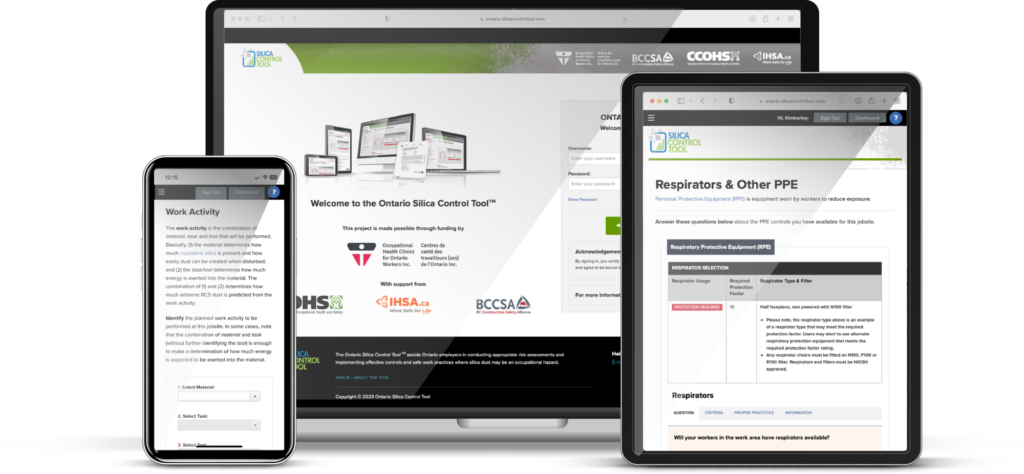
Above is a grouping of resources featured in the Heat Stress Toolkit. It includes pamphlets, infographics, videos calculators and pdf materials in multiple languages.
Some infographics in this series include:
Heat Stress Risk Factors
Heat Stress Symptoms
Heat Stress Warning Signs
Heat Stress Effects
Heat Stress Acclimatization
Heat Stress Response Plan
Research Papers
Every year OHCOW's specialists participate in research to further knowledge and understanding of issues surrounding occupational health. Much of this research centres on lung disease caused by work in the mining field and other work environments, among other topics. These papers are extensively read and cited in the occupational health medical community.
A research paper from 2022 published by OHCOW researchers has ranked among the top 10% of downloaded papers in the American Journal of Industrial Medicine. Sarcoidosis in Northern Ontario hard-rock miners: A case series was written by L. Christine Oliver MD, MPH, MS, Paul Sampara MEng, ROH, Donna Pearson RN, DOHN, Janice Martell BA, and Andrew M. Zarnke, BS.
In 2023, Andrew Zarnke, OHCOW Project Director, successfully defended his PhD thesis in Human Kinetics from Laurentian University. The report he co-authored describes a series of 12 cases of sarcoidosis in a group of hard-rock miners in Northern Ontario, Canada. The group had occupational exposure to silica and metal dusts consistent with previously reported associations. It is believed that the paper is the first such report about hard-rock miners.
The Journal commented in an email to co-author Andrew Zarnke that, "this achievement is a testament to the recognition and celebration of your work within the community."
Congratulations to the team!
Prepared by:
L. Christine Oliver, MD, MPH, MSc, FACPM
Medical Consultant, OHCOW
Occupational Hygiene Review:
Krista Thompson, MHSc, ROH, CRSP
Occupational Hygienist, OHCOW
Editorial Review:
Janice Martell
Occupational Health Coordinator, OHCOW
EXERPT: Idiopathic pulmonary fibrosis (IPF) is a member of the family of interstitial lung diseases known as idiopathic interstitial pneumonias (IIP). IPF is the most common of the IIPs.1,2 Histologically it is characterized and defined by patchy distribution of fibrosis that appears to arise from the pleural surface; foci of subepithelial fibroblasts; and microscopic honeycombing.1,3 This pattern is classified as “usual interstitial pneumonia”, or UIP.1,4
Prepared by: Paul Sampara, MEng, ROHOccupational Hygienist, OHCOW
Last Updated April 18, 2023
Medical Review: Dr. Christine Oliver, MD, MPH, MS, FACPM, Medical Consultant OHCOW Occupational Hygiene Review: Kevin Hedges PhD, CIH, Occupational Hygienist OHCOW Editorial Review: Janice Martell, Occupational Health Coordinator, OHCOW
Ontario hard rock miners have been exposed to four major carcinogens: respirable crystalline silica (RCS), diesel exhaust (DE), radon or radon decay products (RDP)a and arsenic for many decades. The following is a summary of the findings from published scientific literature on the association between exposure to these carcinogens and the risk of lung cancer among miners and in particular among Ontario uranium or gold miners. A number of relevant studies have been published in the last 10-15 years.
Prepared by: Paul Sampara, BSc., DOHS, MEng, ROH Occupational Hygiene Consultant OHCOW
Last updated: October 1, 2019
Medical Review by: Dr. L. Christine Oliver, MD, MPH, MS, FACPM Medical Consultant OHCOW
Occupational hygiene review by: Martin Albinger, Occupational Hygiene Consultant OHCOW
Editorial Review by: Janice Martell, Occupational Health Coordinator OHCOW
A summary of the development of the current WSIB Policy 23-02-03 “Lung Cancer Among Workers in the Uranium Mining Industry” and the epidemiological studies on the risk of lung cancer from radon exposure in Ontario uranium mines, and describes how exposure to radon was determined for the studies that provided the basis for the WSIB policy. A discussion of the historical radon exposure data for Ontario uranium miners is provided followed by a summary of the epidemiological studies on the risk of lung cancer associated with radon exposure in Ontario uranium mines.
Knowledge Translation
At OHCOW we know the importance of disseminating research and knowledge in a way our audience can best receive and use it. The pandemic accelerated the transition to virtual webinars and away from in-person events. Printed material is mostly distributed over the internet to print out. Our regular podcast series, Oh-Pods, has a consistent audience. 23-24 was a good year for OHCOW's goal of making materials and information easy to access and use.
Subscribers to our Youtube channel increased almost 30% over the course of a year, and more than 38,000 views of webinars and other materials took place. Our website saw 102,000 users and more than nine thousand pdfs and other materials were downloaded.
Increased Viewership
OHCOW continued with its highly popular webinar series, and saw excellent attendance. The Repetitive Strain Day series broke its previous record and is the most highly attended series in OHCOW's history. Live attendance for the 4 sessions was between 536-822 people. Youtube views increase this number substantially, and the RSI videos continue to be among the highest viewed on the OHCOW channel.
OHCOW is pleased with the response to its Occupational Health podcasts, known as OH-Pods, and focus on both ergonomics and Occupational Hygiene. To date 23 OH-Pod sessions have been downloaded a total of 3,941 times.
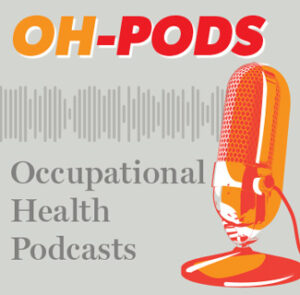 Mar 12, 2024
Mar 12, 2024
The Dangers of Silica in the Workplace: Silica in the News
Jan 29, 2024
In this episode of the IHSA Safety Podcast, Jasmine Kalsi, IHSA’s Occupational Hygienist, and Shirly Yan, Occupational Hygienist at the Occupational Health Clinics for Ontario Workers (OHCOW), discuss the hazards posed by silica in construction.
The Dangers of Silica in the Workplace
Nov 14, 2023
Oct 6, 2023
Ergonomics and Musculoskeletal Disorders
Jul 17, 2023
Introduction to Welding with a Focus on Health Effects
May 5, 2023
Our Nurses. Our Future. The Role of the Occupational Health Nurse at OHCOW
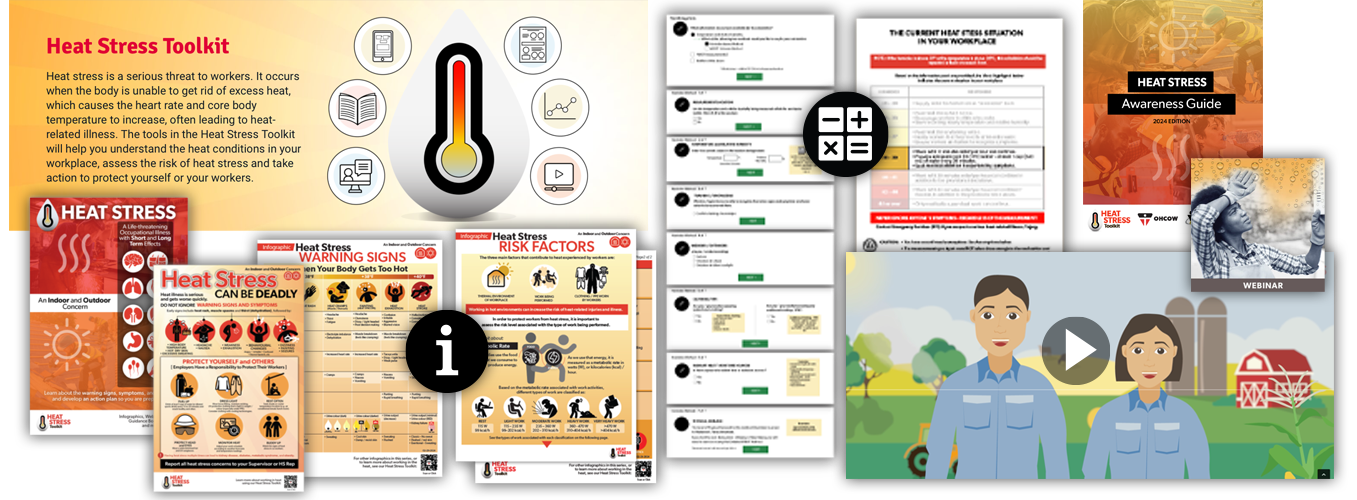
Above is a grouping of resources featured in the Heat Stress Toolkit. It includes pamphlets, infographics, videos calculators and pdf materials in multiple languages.
Some infographics in this series include:
Heat Stress Risk Factors
Heat Stress Symptoms
Heat Stress Warning Signs
Heat Stress Effects
Heat Stress Acclimatization
Heat Stress Response Plan
OHCOW continues to producing infographics on pertinent topics, aimed at both general and specific workers groups, such as outdoor workers, foreign workers, specific industries, and more.
Allergies and Occupational Asthma in Cannabis Production
Workers in the cannabis production industry can develop allergies and occupational asthma. There are many hazards that have been identified in the cannabis cultivation and production industry that the workers are exposed to, during all the stages of cannabis cultivation.
This infographic gives an outline of health concerns for cannabis production workers. You can download the pdf for your reference, print it out to post in a work area, or email it to others.
Stay Hydrated in the Heat
Heat Stress – A Serious Hazard for Outdoor Workers
Produced by OHCOW, this 4-page infographic covers the signs and symptoms of heat stress, presents ideas for action if you or someone else shows symptoms as well as prevention tips for working outdoors. We also cover employer responsibilities, and provide links to additional tools and resources. This is a great resource for posting in your workplace or downloading and printing as a handout for workers or training sessions. Available in 4 languages.
Heat Stress – A Year Round Concern in Greenhouses
Produced by OHCOW, this 4-page infographic aimed at temporary and foreign greenhouse workers outlines the dangers of heat stress and its related illnesses. From the early signs, to heat exhaustion and heat stroke, we cover all the signs and symptoms to watch for, outline the action to take if you or someone you are working with experiences symptoms, and provide prevention tips for while at work. We also cover employer responsibilities and provide links to additional resources. This is a great resource for posting in your workplace or downloading and printing as a handout for workers or training sessions.
Posters Promoting Protection Against Airborne Virus
Wildfire Smoke – A Definite Concern for All [Ontario] Workers
Produced by OHCOW, this 4-page infographic covers the signs and symptoms of wildfire smoke exposure as well as tips for prevention when working indoors and outdoors. We also cover employer responsibilities, provide AQHI health recommendations as well as links to additional tools and resources. This is a great resource for posting in your workplace or downloading and printing as a handout for workers or training sessions. In five languages.
Connections
Through web and social media, OHCOW has continued to maintain connections with our stakeholders and audience.
Exploring New Design, Functionality and Architecture
A new website design and organization is in the works with consultation from stakeholders. Timeline is the new year 2025. In the meantime, the design and layout of some pages has been reconsidered.
OHCOW sends electronic newsletters and bulletins to subscribers every month, promoting our webinars, events and general occupational health news. This year we have increased our subscriber by 15% to 5,614 recipients.
In the 2023/24 year, OHCOW commemorated 20 different noteable dates such as Parkinsons Awareness Month, Day of Mourning, Workplace Mental Health Day, Rare Diseases Day, World Cancer Day, Black History Month and more. We also posted promotions for webinars and other events such as Spring Into Action. Ads for the OHCOW special project promoting the Silica Control Tool also were featured.
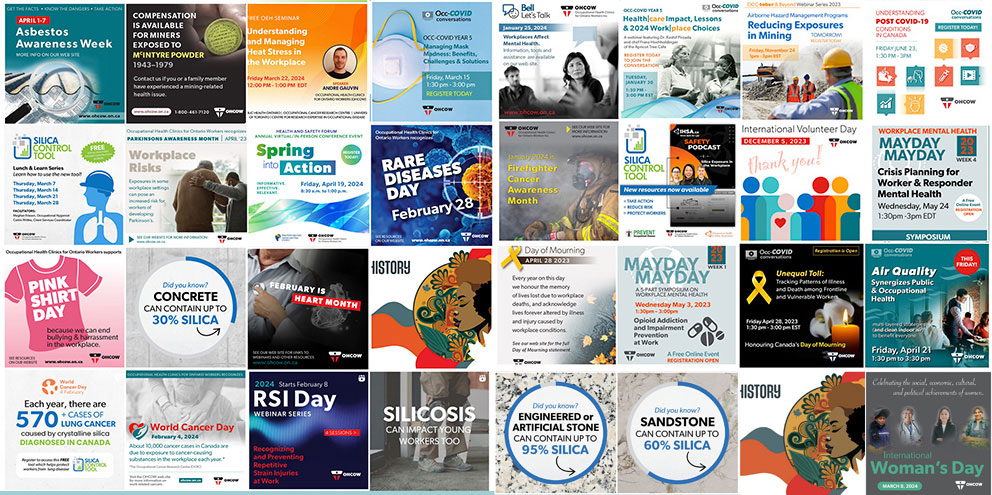
Partnerships
![]() Spring into Action is a virtual forum presented every year, sponsored/Organized by the Ottawa & District Labour Council and the Occupational Health Clinics for Ontario Workers. In the 23/24 year it occured on April 14th.
Spring into Action is a virtual forum presented every year, sponsored/Organized by the Ottawa & District Labour Council and the Occupational Health Clinics for Ontario Workers. In the 23/24 year it occured on April 14th.
Introduction
Elder Terry McKay (Welcoming and Land Acknowledgement)
David Chezzi, Sean McKinney, Kimberly O'Connell
Presentations:
Temporary Foreign Workers Eastern Ontario Project
Eduardo Huesca & Leonor Cedillo (OHCOW)
Long COVID- Medical and Worker’s Compensation Implications
Dr. Pravesh Jugnundan (OHCOW), Margaret Keys (OWA)
BREATHING CLEANER AIR is as important as drinking clean water - what can we do?
Kevin Hedges (OHCOW)
Now Web-Based, and Available as APPS!
 The updated Ergonomics Reference guide now exists as a web-based, live document. It has been changed to reflect difference in office tools (such as multiple monitors and tablets), and working arrangements due to COVID-19 such as temporary workstations.
The updated Ergonomics Reference guide now exists as a web-based, live document. It has been changed to reflect difference in office tools (such as multiple monitors and tablets), and working arrangements due to COVID-19 such as temporary workstations.
Office ergonomics is more important now than it has ever been before in our efforts to decrease and/or eliminate musculoskeletal disorders. Many workplaces do not have the financial resources (or time) to correctly train their workers in ergonomics, and specifically to identify and correct office set-up and use challenges. Building on the popular Office Ergonomics Ergo Reference Guide, the Office Ergonomics e-Learning Course breaks down the key ergonomic principles of workstation components into modules that allow users to progress at their own pace, while learning how to recognize, assess, and control the ergonomic hazards related to computer work wherever it is done.
